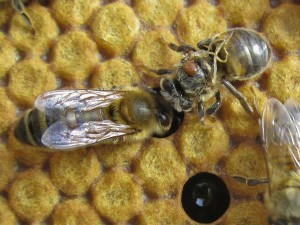Mystery of the ‘superbees’ solved
The mystery of the apparently Varroa-resistant honeybees in a UK apiary has been solved, and the answer has been a real surprise.
Over the past few years there have been dramatic headlines about what seem to have been Varroa-resistant honeybees in the apiary of a beekeeper in Swindon, England (not far from Vita’s HQ). Ron Hoskins’ bees have been dubbed «super bees» and it was thought that their hygienic behaviour was the reason for their success.
However, new research presented by Catherine Thompson of Salford University at the UK National Honey Show last Friday and now published in The ISME Journal has revealed the reasons for Hoskins’ bees’ success. A non-lethal form of Deformed Wing Virus (DWV) is prevalent amongst his bees and is acting to exclude the more lethal form.
DWV is now well-known as a killer of honeybees and its virulence seems at least in part to have been caused by Varroa which, because it injects the virus straight into the bees’ bloodstream, has spread the virus with disastrous effects. Honeybees have long had DMV, but pre-Varroa spread by sex and other methods had not enabled it to spread so quickly and thoroughly throughout a colony.
For reasons that are not yet understood, Hoskins’ bees have been subject to a relatively benign version of DWV — Type B. In contrast DWV Type A is lethal. Type B has become dominant in Hoskins’ apiary and kept Type A out — or at least at very low levels. It is even thought that Varroa spreading Type B have in effect inoculated the bees against Type A!
Unfortunately, simply moving Hoskins’ bees to another apiary where DWV Type A is dominant is likely to be futile. The colony is likely to be swamped by the lethal Type A and face the disease threat common to most colonies.
Nonetheless, it is hoped that this exciting new finding may eventually help in some way to produce a break-through in helping honeybees.

